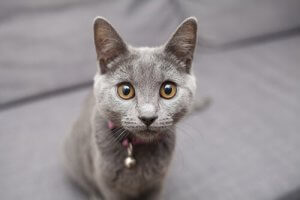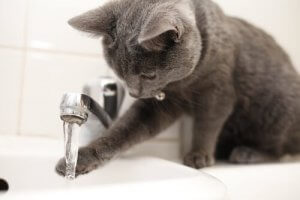Discover the Rare Chartreux Cat

The Chartreux cat is a large, muscular breed, with thick, blue or silver-gray fur and a laid back temperament. Another well-known feature of this breed is their characteristic “smile”.
A breed on the brink of extinction
Many people believe that these cats were first bred in the Parisian monasteries of the Carthusian monks. There, they were primarily used to hunt rodents and keep pest populations down.
However, while it’s often thought that the breed has been based in France for centuries, another theory suggests that the Chartreux’s ancestors may have originated from the mountain regions of Turkey and Iran, before being introduced to France in the Middle Ages thanks to trade between Europe and the East.
While most of us wouldn’t even dream of seeing the Chartreux as anything more than a family pet, in the past, its lustrous coat was often used by furriers. There were even breeding programs to help meet the huge demand for fur coats.
As a result, the breed was driven to the brink of extinction. However, at the end of the 1920s, the Léger sisters began to develop, strengthen, and rebuild the Chartreux population, using feline colonies from the island of Belle-Ile-en-Mer. Today, the Chartreux is recognized by all the main feline breed associations around the world, and enjoys great popularity.

The Chartreux is a robust breed that stands out for its thick, slate-gray coat, and for the large smiles that seem to light up their faces.
The Chartreux, the smiling cat
Here are some of the most notable features of the Chartreux cat:
- Size: medium
- Weight: between 10 and 15 lbs for males, and 6.5 – 11 lbs for females
- Build: compact and solid
- Legs: straight and muscular – they can be short or medium length, with small, round paws
- Tail: medium length, but thick at the base – they gradually taper toward the end to form a rounded tip
- Head: large and wide, their heads are shaped almost like an inverted trapezium, but with rounded edges
- Nose: wide and straight
- Ears: tall and erect, they’re narrow at the base and rounded at the tip – they’re constantly on the alert
- Eyes: large and round, the outer corner of their eyes is angled slightly upward, and the color can range from a bright yellow to a deep copper
- Cheeks: full, round and set low on their faces – they’re particularly prominent in males
- Muzzle: narrow in comparison to the head, but not pointed. They have very pronounced mustaches and whisker breaks (the area between the cheeks and the muzzle) which gives them their smiley expression.
- Neck: short, thick and strong
- Coat: short, dense and shiny – their fur has a firm, plush feel, almost like sheep’s wool
- Color: they come in a range of different blue-gray tones (a dilute version of black fur), and their coat should be a single, uniform color
A natural-born hunter
Although they weren’t kept as pets until the 19th Century, the Chartreux is the ideal family pet. Affectionate, sociable, and playful, they generally get on well with children, and can live in households with other pets.

This natural born hunter can adapt well to life as a house cat. That said, they do prefer to have access to a garden or some other outdoor space. Curious, docile and laid-back, they often display slightly canine qualities.
Easy-going and independent, these felines very rarely meow, and sleep most of the day. Although they can be shy around strangers, they often enjoy following their owners everywhere they go, and dislike being alone for long periods of time.
How to care for a Chartreux cat
With a life expectancy ranging between 12 and 15 years, the Chartreux has no genetic predispositions to disease. Natural selection has made it one of the healthiest of all the cat breeds.
Their short coats don’t require huge amounts of care. A thorough brushing once a week should be enough to stop dead hair building up. However, it’s important to keep an eye on their ears, as they tend to produce more earwax than other breeds.
As with any pet, they’ll need a healthy diet, regular check-ups at the vet, full vaccinations, de-worming and flea treatment, to keep them happy and healthy in the long-term.
The Chartreux cat is a large, muscular breed, with thick, blue or silver-gray fur and a laid back temperament. Another well-known feature of this breed is their characteristic “smile”.
A breed on the brink of extinction
Many people believe that these cats were first bred in the Parisian monasteries of the Carthusian monks. There, they were primarily used to hunt rodents and keep pest populations down.
However, while it’s often thought that the breed has been based in France for centuries, another theory suggests that the Chartreux’s ancestors may have originated from the mountain regions of Turkey and Iran, before being introduced to France in the Middle Ages thanks to trade between Europe and the East.
While most of us wouldn’t even dream of seeing the Chartreux as anything more than a family pet, in the past, its lustrous coat was often used by furriers. There were even breeding programs to help meet the huge demand for fur coats.
As a result, the breed was driven to the brink of extinction. However, at the end of the 1920s, the Léger sisters began to develop, strengthen, and rebuild the Chartreux population, using feline colonies from the island of Belle-Ile-en-Mer. Today, the Chartreux is recognized by all the main feline breed associations around the world, and enjoys great popularity.

The Chartreux is a robust breed that stands out for its thick, slate-gray coat, and for the large smiles that seem to light up their faces.
The Chartreux, the smiling cat
Here are some of the most notable features of the Chartreux cat:
- Size: medium
- Weight: between 10 and 15 lbs for males, and 6.5 – 11 lbs for females
- Build: compact and solid
- Legs: straight and muscular – they can be short or medium length, with small, round paws
- Tail: medium length, but thick at the base – they gradually taper toward the end to form a rounded tip
- Head: large and wide, their heads are shaped almost like an inverted trapezium, but with rounded edges
- Nose: wide and straight
- Ears: tall and erect, they’re narrow at the base and rounded at the tip – they’re constantly on the alert
- Eyes: large and round, the outer corner of their eyes is angled slightly upward, and the color can range from a bright yellow to a deep copper
- Cheeks: full, round and set low on their faces – they’re particularly prominent in males
- Muzzle: narrow in comparison to the head, but not pointed. They have very pronounced mustaches and whisker breaks (the area between the cheeks and the muzzle) which gives them their smiley expression.
- Neck: short, thick and strong
- Coat: short, dense and shiny – their fur has a firm, plush feel, almost like sheep’s wool
- Color: they come in a range of different blue-gray tones (a dilute version of black fur), and their coat should be a single, uniform color
A natural-born hunter
Although they weren’t kept as pets until the 19th Century, the Chartreux is the ideal family pet. Affectionate, sociable, and playful, they generally get on well with children, and can live in households with other pets.

This natural born hunter can adapt well to life as a house cat. That said, they do prefer to have access to a garden or some other outdoor space. Curious, docile and laid-back, they often display slightly canine qualities.
Easy-going and independent, these felines very rarely meow, and sleep most of the day. Although they can be shy around strangers, they often enjoy following their owners everywhere they go, and dislike being alone for long periods of time.
How to care for a Chartreux cat
With a life expectancy ranging between 12 and 15 years, the Chartreux has no genetic predispositions to disease. Natural selection has made it one of the healthiest of all the cat breeds.
Their short coats don’t require huge amounts of care. A thorough brushing once a week should be enough to stop dead hair building up. However, it’s important to keep an eye on their ears, as they tend to produce more earwax than other breeds.
As with any pet, they’ll need a healthy diet, regular check-ups at the vet, full vaccinations, de-worming and flea treatment, to keep them happy and healthy in the long-term.
This text is provided for informational purposes only and does not replace consultation with a professional. If in doubt, consult your specialist.








